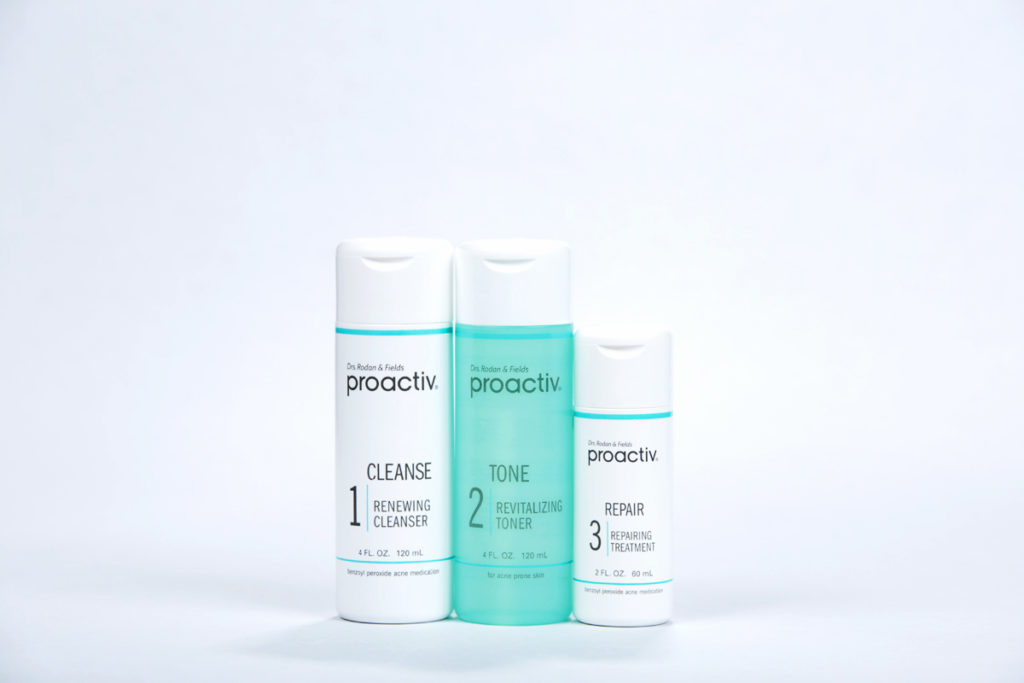PROACTIV

What is Proactiv?
Proactiv Solution was designed to go beyond the “spot treatments” of traditional acne medicine and attack the oil, inflammation and bacteria. The Proactiv products can be purchased over-the-counter and they are a mix of cleanser’s, toners and lotions applied to the skin to help cure and prevent acne.
Proactiv Claims and Uses
Proactiv is a topical acne “system” that is available without a prescription. According to their website, “Proactiv is safe and effective for almost everyone with mild to moderate acne”. (1) It is reported to heal current breakouts and help to prevent future breakouts. Due to breakout prevention, Proactiv also helps to keep blemishes from leaving behind permanent scars. (1)
Proactiv is a 3-step system that combines mild concentrations of antimicrobial acne medicine with botanical skin-care agents to “gently remove excess dead skin cells and oil (to keep pores from clogging); to kill acne causing bacteria inside pores; and to soothe redness and irritation.” (1)
The first part of the Proactiv system is the “Renew” cleanser. This has “micro-crystal benzoyl peroxide” (2) technology with fine particles designed to quickly penetrate pores to kill acne-causing bacteria on contact. The cleanser also contains exfoliating beads to remove dirt, excess oil and dead skin cells to help keep pores from clogging. (2)
The second step is an alcohol-free toner that is said to help remove impurities and excess oil. Glycolic acid in the toner exfoliates dead skin cells and is combined with botanical agents to balance skin tone. (2) The final step is a medicated lotion with prescription-grade benzoyl peroxide (BPO) as an antimicrobial. This will often produce dryness and another noncomedogenic moisturizer can be used. (4)
How Benzoyl Peroxide Works
Benzoyl peroxide is the most commonly used topical antimicrobial agent that is used to decrease the number of P. acnes (bacteria that causes acne) colonizing the skin, with the goal of reducing the inflammatory response that occurs in acne. (3) Benzoyl peroxide is antibacterial and also comedolytic (it breaks up comedones and opens clogged pores). (3)
Studies
Benzoyl peroxide comes in prescription and non-prescription products in concentrations of 2.5 to 10%. In the proactive system is comes as 2.5% benzoyl peroxide and is usually applied twice daily. (2) Higher concentrations of benzoyl peroxide may not contribute to increased benefit. In one study, 2.5% benzoyl peroxide was as effective as 10% benzoyl peroxide in reducing the number of inflammatory acne lesions. (3) However, increased concentrations can lead to increased skin irritation.
In another open-label, patient-satisfaction, 8-week comparative study, 23 patients demonstrating mild to moderate facial acne were given randomly either benzoyl peroxide in Proactiv Solution or the combination of benzoyl peroxide with an allylamine. The results showed that the allylamine–benzoyl peroxide combination therapy outperformed Proactiv Solution during each 2-week stage of evaluation in terms of reduction of comedones, inflammatory lesions, and degree of oiliness. There was a marked preference for the allylamine–benzoyl peroxide combination in terms of patient satisfaction. (5)
There are several different types of acne, and the type of acne should be identified prior to a patient starting treatment. For patients with mild to moderate inflammatory acne with or without prominent comedonal lesions, studies suggest the use of a topical retinoid, topical antibiotic, and benzoyl peroxide in a combination therapy. (3) When benzoyl peroxide is used with a topical antibiotic, treatment is more effective than either agent alone and benzoyl peroxide reduces the risk of antibiotic resistance. For patients with more sever inflammatory acne, oral antibiotics should be added to the regimen of therapy. (3)
Side Effects and Warnings
When using a product like Proactiv with Benzoyl peroxide using other topical acne medications at the same time or immediately following use of this product may increase dryness or irritation of the skin. (4) If this occurs, only one medication should be used unless directed by a doctor. Up to 2.5 percent of patients may develop a true contact sensitivity to benzoyl peroxide, and will not be able to use the medication. (3) Sensitivity to Proactiv is usually characterized by redness, burning, itching, peeling or possibly swelling. (4) Patients should also be advised that benzoyl peroxide can cause bleaching of the hair and clothing, and that using sunscreen every day is important. (3) Benzoyl peroxide sensitizes the skin to UV damage from the sun.
- Renewing: A cleanser made with new, exclusive micro-crystal benzoyl peroxide, featuring smaller, finer particles designed to quickly penetrate pores to start killing acne-causing bacteria on contact
- Revitalize: Toner helps remove impurities and excess oil so the skin looks and feels clean, soft and refreshed
- Repair: Lotion that penetrates deep into clogged pores faster but is designed to be gentler on the skin. Lotion is made from an oil-free formula
References:
- Ofori, A. Treatment of acne vulgaris. August 20, 2010. http://www.uptodate.com/contents/treatment-of-acne-vulgaris?source=search_result&selectedTitle=1%7E150#H14
- Craig G. Burkhart. Treatment of acne vulgaris without antibiotics: tertiary amine–benzoyl peroxide combination vs. benzoyl peroxide alone (Proactiv Solution™) International Journal of Dermatology Volume 46, Issue 1, pages 89–93, January 2007


